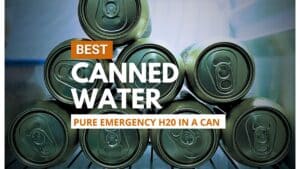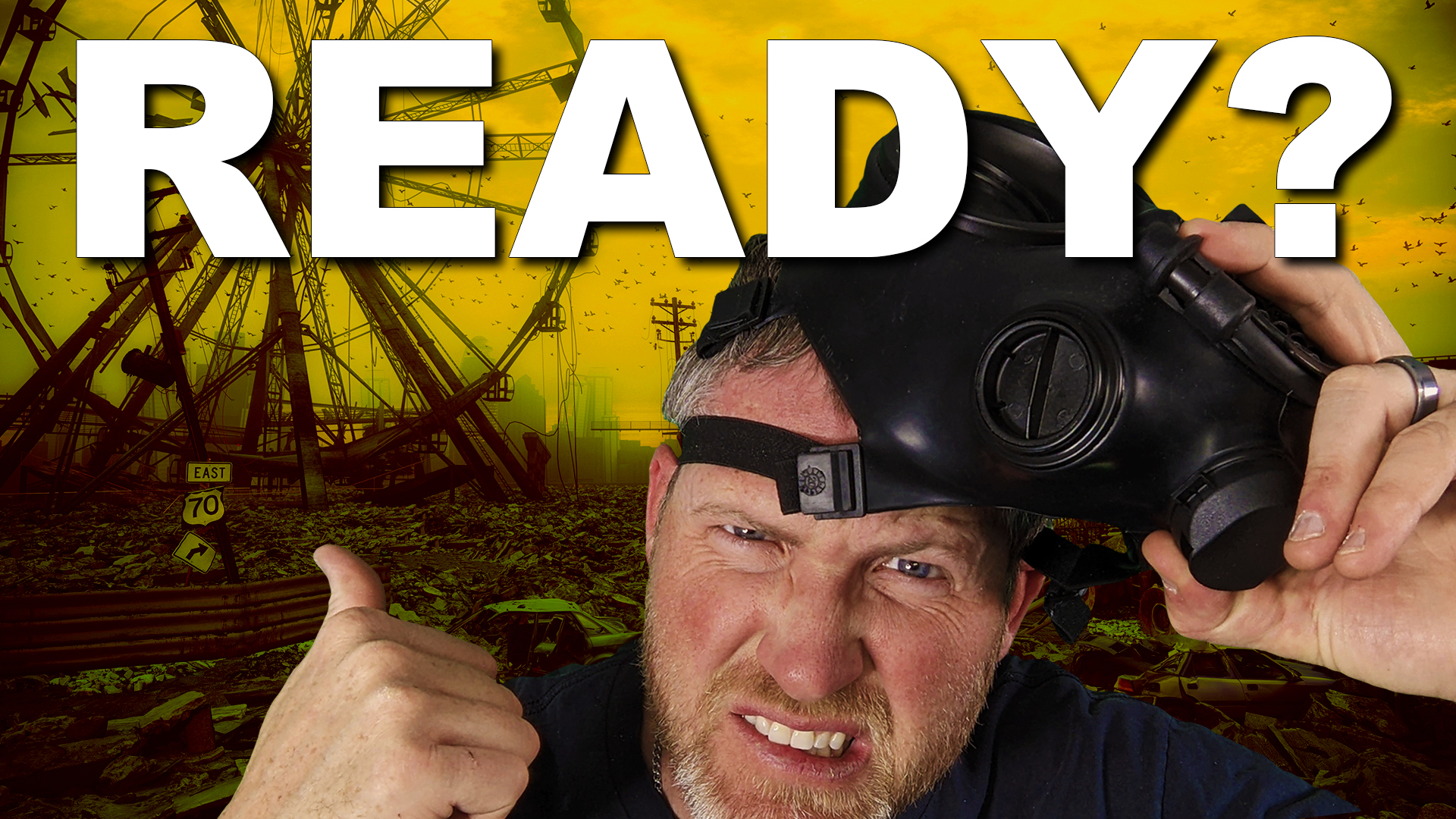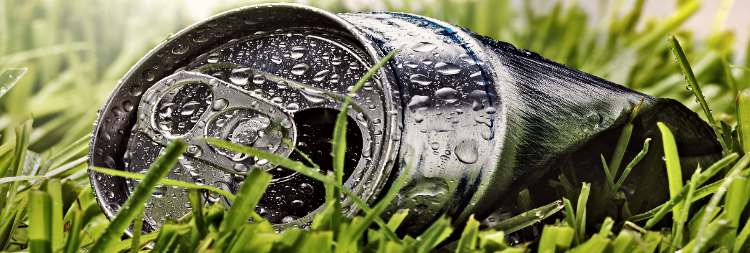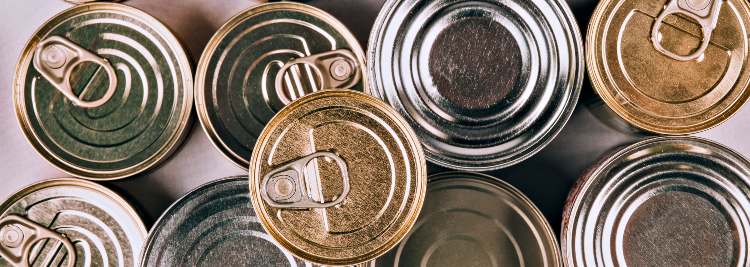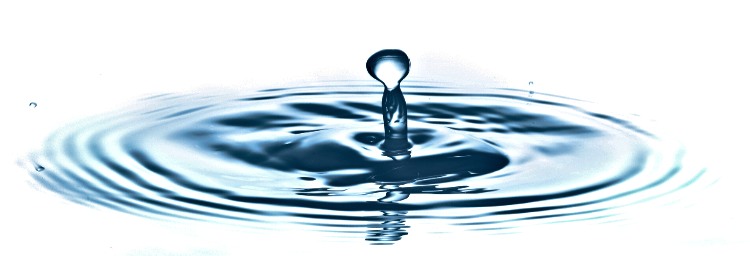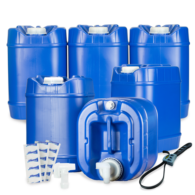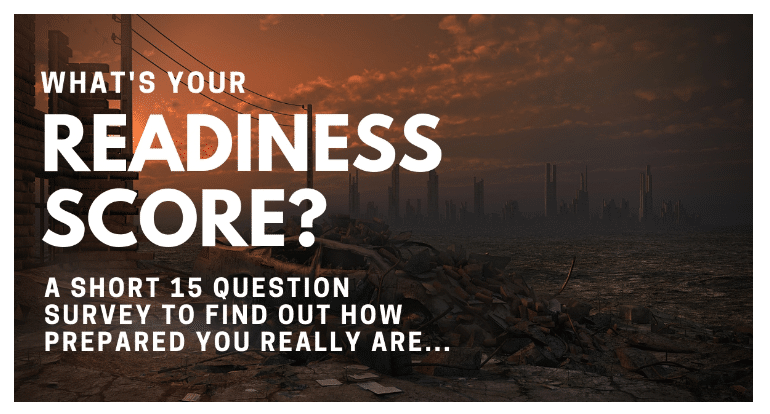Looking For The Best Canned Water? You’ve Come To The Right Place!
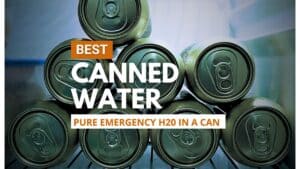
Just determine how much you need, purchase, and put it on the shelf.
Done, right?
You can avoid the hassles of purchasing other emergency water containers, such as:
- Stackable plastic containers
- 50-gallon drums
- Large tanks
- Water bladders
- etc.
However, these “other” water storage options take more effort and education.
For example:
You’ll need to purify the water before you add it to these containers.
And you may also need a rotation plan as well.
Plus, there are many amateur mistakes you’ll want to avoid to keep your water safe for the long haul.
And that’s the beautiful thing about water in a can – it’s pretty much foolproof!
Not that you’re a fool if you choose this option.
Heck, it’s genius, IF you can afford it (which we’ll talk about later).
The bottom line is:
Canned water makes stockpiling water easy and foolproof.
They help avoid mistakes and keep things safe and sanitary.
That’s why today I’ll use my Engineering Degree, 10 Years in Food Manufacturing & a lifetime in Preparedness to cover:
TABLE OF CONTENTS
Best Canned Water For Sale
What Exactly Is Canned Water?
Best Canned Water Features
Why Invest In Water Via Cans
How Much Water Do You Need?
Why Is Canned Water Expensive
Are You Ready For The Tough Times Ahead? Take My 60 Sec Quiz To See If You’re Part Of ‘The Fragile Masses’ Or Not… Start Quiz Now!
Best Canned Water On The Market Today
Blue Can 50 Year Shelf Life Water
Ok, so maybe the price isn’t an obstacle for you.
Great, because Blue Can Water is AWESOME!
Why? Because each case of Blue Can Water contains 24 cans, which is 288 oz or 2.25 gallons per case.
The box is made from enclosed double-thick corrugated cardboard, making it perfect for storage.
The water and packaging comply with standards for purified drinking water with a 50-year shelf life.
All cans are made of corrosion-resistant aluminum and are hermetically sealed.
- Lab-tested and lab-certified 50-year shelf-life
- Each pack is enough for a two-day supply
- Great reserve for in the house or on the boat
- Stays Fresh In Heat
- Outstanding Taste
- No More Rotating Stock
- Ability To Double-Stack Pallets
- Hermetically Sealed
This is the best-canned water on the market today!
↓ Blue Can Emergency Water Review: 50-Year Shelf Life! ↓
What Exactly Is Canned Water?
No need to make this complicated – it’s water put into sealed aluminum cans.
That Was Easy, right?
Not so fast.
Not all canned water is created equal. Some are worth your hard-earned dollars, while others are rubbish.
↓ Canned Water Vs. Plastic Water Bottles: Which Is Better? ↓
As A Way To Introduce You To Skilled Survival, We’re Giving Away Our #78 Item Complete Prepper Checklist. Click Here To Get Your FREE Copy Of It.
Best Canned Water Features To Look For
Can Size
The size of the can shouldn’t be too small or too large.
Why? Because if the cans are too small, you’ll be spending more money than necessary.
Smaller cans require more aluminum per ounce of water.
However, if the cans are too large, they are difficult to handle individually due to their weight.
Large cans are harder to keep organized, and stacking them could become an issue due to crushing.
The ideal can size is roughly 40 fl. oz per can.
Quality Seals
The last thing you want your canned water to do is leak all over.
That would be an absolute mess, and you’d lose your entire investment.
However, canning is a well-established process nowadays.
So the odds of getting a batch of cans with poor seals are very low.
But that doesn’t mean it CAN’T happen.
So check any cans you receive immediately and return them if any of the cans look suspicious.
No Pop Tabs
You DO NOT want the cans to look like soda cans.
These cans have pop tabs on top to make it simple to crack them open anywhere WITHOUT a tool.
These pop tabs are great for a soda consumed within a few months from manufacturing.
But they only add a weak point when discussing storing something for decades.
Your emergency canned water should look more like a can of green beans than a soda can.
A design that requires a can opener to get at what’s inside.
These cans are heartier and will last longer without concern.
Long Shelf Life
It’s an investment in your water security for YEARS and DECADES.
So you want to invest in water that will last as long as possible.
Look for a brand with at least 30 years of guaranteed shelf life.
And if you store your water in a safe, cold, dark location, it may last well past this expiration date.
So if you’re investing in your 30s or 40s, this could be a lifetime’s worth of emergency supplies – assuming you never need it.
And if you do need it – THANK GOD you had it!
It’s Purified
You’ll want to ensure that the manufacturer uses purified water, not just regular tap water.
Regular tap water often includes trace amounts of chemicals, bacteria, and organic material.
Over time, these trace contaminants can spur mold growth.
This will make your lifesaving water dangerous to consume!
So make sure the water in the can includes added minerals and alkalinity.
These additions are the key to the water’s safety for at least 30 years or more.
As A Way To Introduce You To Skilled Survival, We’re Giving Away Our #78 Item Complete Prepper Checklist. Click Here To Get Your FREE Copy Of It.
Reason Why You Should Buy In
Water is a precious commodity in emergencies and can become scarce in disasters.
In a best-case scenario, you would never have a reason to dip into your water storage.
But the truth is emergencies and natural disasters happen, and they rarely give us time to prepare.
By stocking up now, you avoid rushing to find freshwater in a disaster.
It’s wiser to prepare now and never use your supply than be empty-handed when disaster strikes.
Keep Family Safe For The Future
Drinking water is essential for survival and having a supply on tap for 30 years.
Confidence IN Preparations
Some brands have a shelf-life of 50 YEARS!
So you never have to worry about it going bad or needing periodic rotation.
Safe Potable Water
Cans of H2O achieve purification by adding minerals and increasing the overall alkalinity.
Easy, Safe Consumption
Storing water in an old-fashioned way can be a time-consuming and challenging affair.
But with cans, you open the top, and it’s ready!
So there’s no need to worry about water purification methods such as:
- boiling
- adding bleach
- adding water tablets
- water rotation strategies
- etc.
As A Way To Introduce You To Skilled Survival, We’re Giving Away Our #78 Item Complete Prepper Checklist. Click Here To Get Your FREE Copy Of It.
How Much Water Should You Stockpile?
Honestly, only YOU can decide how much is right.
However, I can recommend how much I think you should consider stockpiling.
And how to calculate the total gallons necessary to meet that goal.
How Much?
At a bare minimum, you should invest two weeks’ worth of water for your family.
This amount is best if you’re starting on your own stockpiles.
Now, I DO NOT believe that is where you should stop.
But if you’re worried about the future, two weeks will help you get some basic preparations in place.
And if your finances allow, by all means, go big right away – maybe even get a year’s worth now and be done with it.
But most people cannot make such a significant investment.
Once you have two weeks’ worth, it’s time to move to other critical preparations.
Then once those are complete, start adding more water to your stockpile.
Again, if you’re starting with preparedness, I recommend you read my Prepping 101 – Basic Prepping Guide.
It’s 100% FREE!
Add more water to your supplies once ALL your other basic preps are in place.
Ultimately, I like targeting at least three months of water to live a resilient life.
And if you’re extremely anxious about a doomsday scenario, shoot for one year’s worth of water.
But start at two weeks, then move on to two months and keep going if it suits you.
How To Calculate How Much You Need
Ok, this can be a bit tricky.
According to FEMA, individuals should drink at least half a gallon of water daily. Update: FEMA has since upped their recommendation to 1 gallon per person.
So that’s the bare minimum.
But FEMA’s not considering what people need for food prep and sanitation needs.
That’s why I like to add another half gallon to that recommendation.
And I estimate using 1 gallon per person per day (instead of a half gallon).
Update: FEMA has since upped their recommendation to 1 gallon per person.
Then you’ll know you have plenty.
Otherwise, you may end up short of what you “THOUGHT” you had when the crisis hits—running low while cooking your meals, washing your face, and flushing your toilet.
If you agree with my assessment, then the math is relatively easy to calculate.
(# OF FAMILY MEMBERS) X (1 GALLON) X (# OF DAYS) = # GALLONS YOU MUST STOCKPILE
Note: family members may include pets, especially any large-breed dogs
So let’s say you have a family of 4 and want two months of emergency water.
(A Family of 4) X (1 Gallon Per Person) X (60 Days) = 240 Gallons
NOTE:
You may want to separate your drinking water and food/sanitation water.
This strategy allows you to use your canned H20 for drinking.
And use other water storage methods for your cooking and sanitation needs.
This strategy can save money since canned water is so expensive.
In this case, use ½ gallon for your water needs and ½ gallon for your “other” water needs.
So the equation would become 4 X 0.5 X 240 = 120 Gallons
But again, I recommend you also store 120 Gallons more.
So you’d need 120 gallons of “other” water.
As A Way To Introduce You To Skilled Survival, We’re Giving Away Our #78 Item Complete Prepper Checklist. Click Here To Get Your FREE Copy Of It.
Why Is Canned Water So Expensive?
Oddly, water is a cheap commodity in much of the modern world.
For example:
Most people in the U.S. pay less than $0.025 per gallon.
These low water costs seem odd to me because water is a precious resource – more valuable than gold.
We need it to live!
That’s why some feel water should be a RIGHT, so keeping it extremely affordable is a human right.
Politics aside, water has traditionally been an abundant resource in most modern cities.
But that concept has been coming into question in recent years.
Cities across the world are beginning to run out of WATER!
But why is water stored in cans much more expensive than in 50-gallon drums or large tanks?
First off, the canned water market isn’t very big.
So there are very few vendors who manufacture it.
On top of this, material costs tend to be more expensive for aluminum, and shipping water is HEAVY!
So shipping costs are WAY higher vs. an empty plastic container.
Honestly, that’s what’s causing the most significant disparity in price.
Plastic containers don’t weigh all that much when shipped empty.
But canned water is filled and shipped from the factory.
So shipping, material, labor costs, and a lack of competition boost the price.
It’s More Expensive…But HOW Much More?
To answer this, let’s make a price comparison:
288 fl. oz. of canned water costs about $49.99 (on the day this post went live).
288 fl. Oz. EQUALS 2.25 Gallons
So if you bought 22 units, that would cost $1,099.78 and would equate to 50 gallons of water.
- A 30 Gallon package of stackable containers currently costs $159.99 (on the day this post went live)
- AND a 20 Gallon package of stackable containers currently costs $114.99 (on the day this post went live)
So 30 Gallons + 20 Gallons = 50 Gallons
OR $159.99 + $ 114.99 = $274.98 for 50 Gallons worth of water storage!
But wait, you still need to fill them with water, BUT (big but) tap water is currently CHEAP.
Even the most costly locations in the U.S. only charge around $0.025 per gallon (in the year 2020).
So at 50 Gallons, that’s only $1.25!!
The total cost for storing 50 gallons of water TODAY using stackable containers IS ONLY = $274.98 + $1.25 = $276.23
So on a cost gallon comparison, you end up with:
So buying water in cans costs over 3X MORE!
Too rich for my blood!
That’s why I bought a bunch of these stackable 5-gallon containers for my emergency water storage needs.
You can read my step-by-step process and the stackable water containers I bought here.
As A Way To Introduce You To Skilled Survival, We’re Giving Away Our #78 Item Complete Prepper Checklist. Click Here To Get Your FREE Copy Of It.
Final Thoughts
Canned water has many pros – easy, foolproof, long shelf life, and safe. But it has one major con – price.
So, if the extra costs don’t bother you, you’ll be delighted with your investment.
It’ll put you at ease, knowing for a FACT you have lifesaving water on hand no matter how insane the world becomes.
Take your future into your own hands – start living a resilient life by investing in a stockpile of H2O.
Prepare, Adapt & Overcome,
P.s. Are you ready for the tough times ahead?
Find out now by taking my short Readiness Score Quiz – it’s absolutely free.
Once complete, you’ll know exactly where you stand on the “fragile” vs.” resilient” spectrum.
So click here to start the Quiz….And don’t worry; the questions are so easy a 3rd grader could answer them.
Click on the image to begin the Quiz and find out once and for all if you’re part of “The Fragile Masses” or “The Resilient Few.”
The post Best Emergency Canned Water For Preparedness And Survival appeared first on Skilled Survival.


